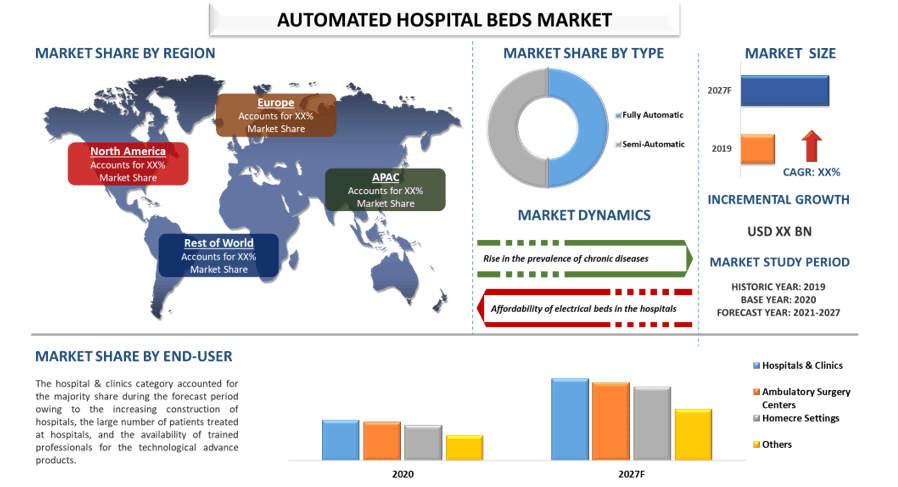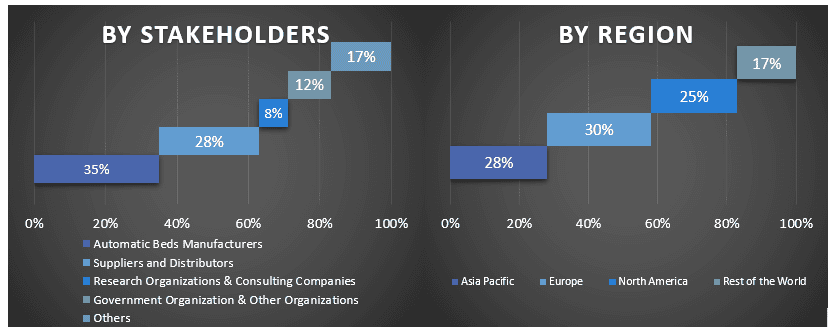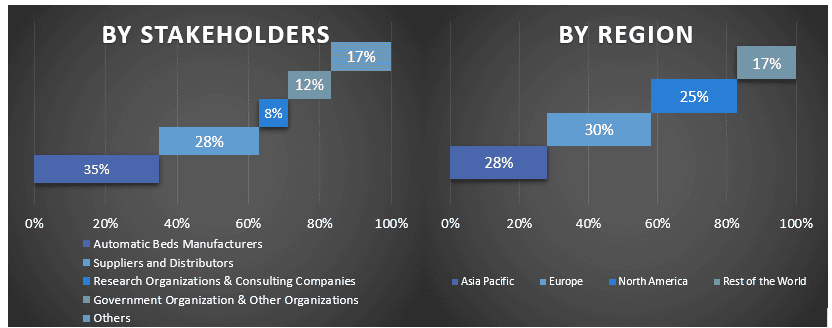Emphasis By Type (Fully Automatic, Semi-Automatic); By End-User (Hospitals & Clinics, Ambulatory Surgery Centers, Homecare Settings, and Others) and Region/Country

The Automated Hospital Bed Market is expected to witness a CAGR of around 5% during the forecast period (2021–2027). Automated hospital beds are innovated for patients with critical conditions. Automated beds have features such as adjustable heights for the entire bed such as patients can control their own movements and make themselves more comfortable. Moreover, automated hospital beds are becoming more popular and expanding at a rapid rate owing to the increasing number of patients with chronic diseases such as cancer, diabetes, and paralysis cases, among others, requiring bed rest and a longer stay at healthcare facilities. These factors will drive the market growth during the forecast period.
Arjo AB, Hill-Rom Holings Inc. (Baxter International Inc.), Invacare Corporation, Stryker Corporation, PARAMOUNT BED HOLDINGS CO. LTD., Bakare Beds Ltd, Gendron Inc., Span-America Medical Systems Inc., Savion Industries Ltd., and LINET spol. s.r.o. are some of the key players in the market. Several M&As along with partnerships have been undertaken by these players to facilitate customers with the new and advanced automated hospital bed. For instance, in December 2021, the acquisition of Hillrom by Baxter International Inc. was finalized. The merger brings together two top medical technology companies with a common goal of revolutionizing healthcare and improving patient care throughout the world.
Insights Presented in the Report
“Amongst Type, the Semi-Automatic category accounted for the majority share in the market in 2020”
Based on type, the automated hospital bed market is segmented into fully automatic, and semi-automatic. The semi-automatic category is anticipated to witness a considerable growth rate during the forecast period owing to the rising prevalence of severe complications such as surgeries, paralysis, spinal cord injury, etc. For instance, according to the World health organization (WHO), Every year, around the world, between 250,000 and 500,000 people suffer a Spinal Cord Injury (SCI). These beds assist in intensive patient care treatments and play a critical role in monitoring and assisting patients and healthcare providers.
“Amongst End-User, the hospitals and clinics category is expected to witness the highest CAGR during the forecast period”
Based on end-user, the automated hospital bed market is categorized into hospitals & clinics, ambulatory surgery centers, home care settings, and others. In 2020, the hospitals & clinics category dominated the automated hospital bed market and is expected to grow significantly in the upcoming years. Moreover, the increasing construction of hospitals, the rising number of patients in ICU, the availability of skilled professionals in the hospitals, surge in the cases of cardiovascular disease, and cancer surgeries are the major factors for the growth of this category during the forecast period.
“North America to witness significant growth during the forecast period”
For a better understanding of the market, the report provides a detailed analysis of major regions and countries including North America (U.S., Canada, Rest of America); Europe (Germany, U.K., France, Spain, Italy, Rest of Europe); Asia-Pacific (China, India, Japan, Australia, Rest of Asia-Pacific) and Rest of World. In 2020, North America accounted for a significant market share. This is mainly due to the rising frequency and prevalence rate of chronic disorders that require longer hospital stays, as well as accidental instances, burn injuries, paralysis, and other bedridden illnesses. For instance, according to the Association for Safe International Road Travel (ASIRT), in the U.S., more than 37,000 people die in road accidents per year and around 2.35 million are injured or disabled.
Reasons to buy this report:
Customization Options:
The automated hospital bed market can further be customized as per the requirement or any other market segment. Besides this, UMI understands that you may have your own business needs, hence feel free to connect with us to get a report that completely suits your requirements.
1. Market Introduction
2. Research Methodology Or Assumption
3. Market Synopsis
4. Executive Summary
5. Automated Hospital Bed Market Covid-19 Impact
6. Automated Hospital Bed Market Revenue, 2019-2027f
7. Market Insights By Type
8. Market Insights By End-user
9. Market Insights By Region
10. Automated Hospital Bed Market Dynamics
11. Automated Hospital Bed Market Opportunities
12. Automated Hospital Bed Market Trends
13. Legal & Regulatory Framework
14. Demand And Supply-side Analysis
15. Value Chain Analysis
16. Competitive Scenario
17. Company Profiled
18. Disclaimer
Analyzing the historical market, estimating the current market, and forecasting the future market of the automated hospital bed market were the three major steps undertaken to create and analyze the adoption of the automated hospital bed market in major regions globally. Exhaustive secondary research was conducted to collect the historical market numbers and estimate the current market size. Secondly, to validate these insights, numerous findings and assumptions were taken into consideration. Moreover, exhaustive primary interviews were also conducted, with industry experts across the value chain of the automated hospital bed market. Post assumption and validation of market numbers through primary interviews, we employed a top-down/bottom-up approach to forecasting the complete market size. Thereafter, market breakdown and data triangulation methods were adopted to estimate and analyze the market size of segments and sub-segments of the industry pertains to. Detailed methodology is explained below:
Seek More Details About Research Methodology
Analysis of Historical Market Size
Step 1: In-Depth Study of Secondary Sources:
Detail secondary study was conducted to obtain the historical market size of the automated hospital bed market through company internal sources such as annual reports & financial statements, performance presentations, press releases, etc., and external sources including journals, news & articles, government publications, competitor publications, sector reports, third-party database, and other credible publications.
Step 2: Market Segmentation:
After obtaining the historical market size of the automated hospital bed market, we conducted a detailed secondary analysis to gather historical market insights and share for different segments & sub-segments for major regions. Major segments are included in the report as type and end-user. Further country-level analyses were conducted to evaluate the overall adoption of testing models in that region.
Step 3: Factor Analysis:
After acquiring the historical market size of different segments and sub-segments, we conducted a detailed factor analysis to estimate the current market size of the automated hospital bed market. Further, we conducted factor analysis using dependent and independent variables such as various type and end-user of the automated hospital bed market. A thorough analysis was conducted for demand and supply-side scenarios considering top partnerships, mergers and acquisitions, business expansion, and product launches in the automated hospital bed market sector across the globe.
Current Market Size Estimate & Forecast
Current Market Sizing: Based on actionable insights from the above 3 steps, we arrived at the current market size, key players in the automated hospital bed market, and market shares of the segments. All the required percentage shares split, and market breakdowns were determined using the above-mentioned secondary approach and were verified through primary interviews.
Estimation & Forecasting: For market estimation and forecast, weights were assigned to different factors including drivers & trends, restraints, and opportunities available for the stakeholders. After analyzing these factors, relevant forecasting techniques i.e., the top-down/bottom-up approach were applied to arrive at the market forecast about 2027 for different segments and sub-segments across the major markets globally. The research methodology adopted to estimate the market size encompasses:
Market Size and Share Validation
Primary Research: In-depth interviews were conducted with the Key Opinion Leaders (KOLs) including Top Level Executives (CXO/VPs, Sales Head, Marketing Head, Operational Head, Regional Head, Country Head, etc.) across major regions. Primary research findings were then summarized, and statistical analysis was performed to prove the stated hypothesis. Inputs from primary research were consolidated with secondary findings, hence turning information into actionable insights.
Split of Primary Participants in Different Regions

Market Engineering
The data triangulation technique was employed to complete the overall market estimation and to arrive at precise statistical numbers for each segment and sub-segment of the automated hospital bed market. Data was split into several segments & sub-segments post studying various parameters and trends in the areas of type and end-user in the automated hospital bed market.
The main objective of the automated hospital bed market Study
The current & future market trends of the automated hospital bed market were pinpointed in the study. Investors can gain strategic insights to base their discretion for investments on the qualitative and quantitative analysis performed in the study. Current and future market trends determined the overall attractiveness of the market at a regional level, providing a platform for the industrial participant to exploit the untapped market to benefit from a first-mover advantage. Other quantitative goals of the studies include:

Customers who bought this item also bought